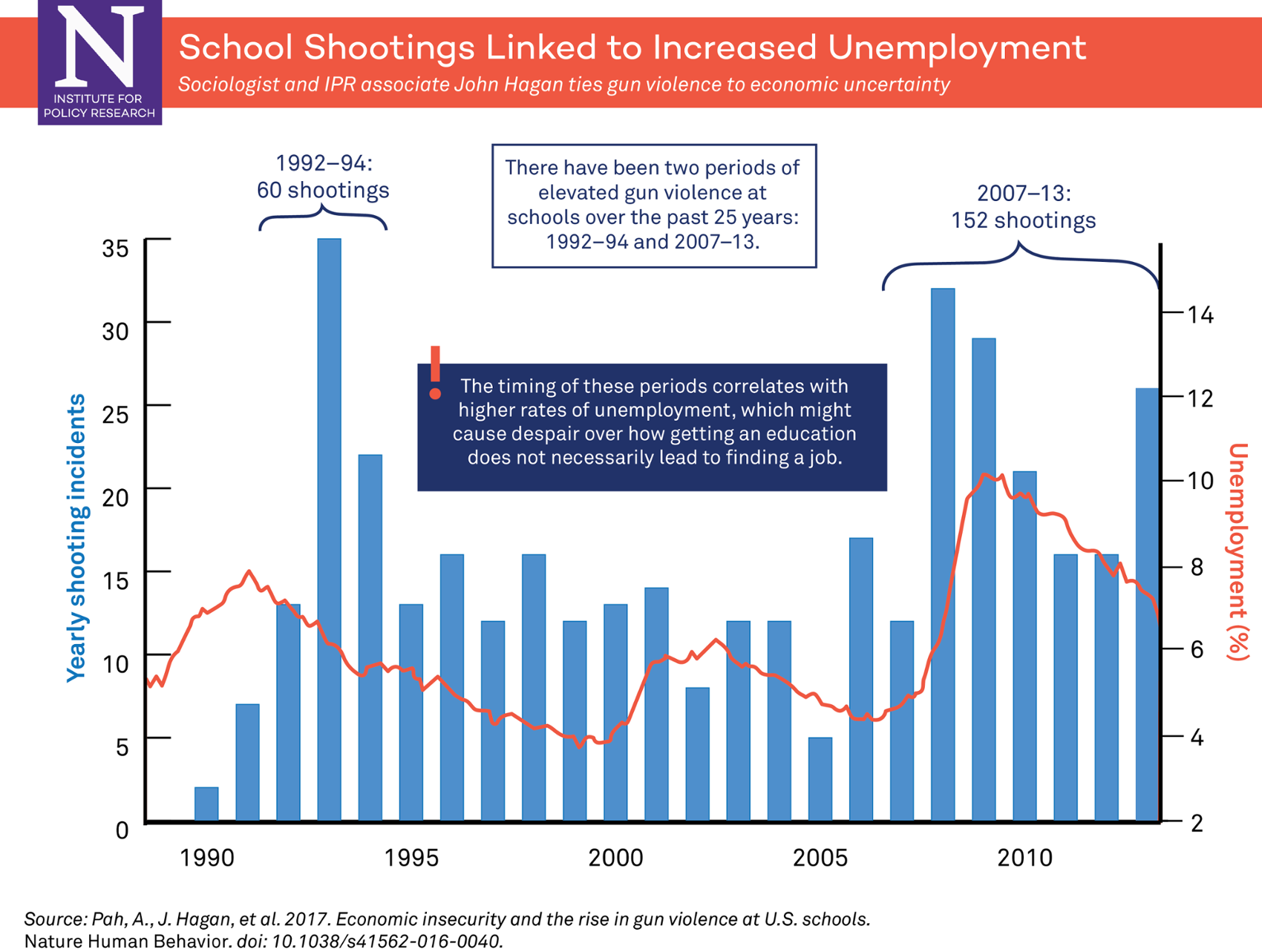Infographic: School Shootings Linked to Increased Unemployment
Sociologist and IPR associate John Hagan ties gun violence to economic uncertainty
Get all our news
Click on the image above to see a larger version of the infographic.
Many researchers have tried to understand why school shootings are a uniquely American phenomenon, but past studies have presented fragmented and even contradictory findings. A new Northwestern study takes a novel approach to the data and reveals a surprising predictor of increases in U.S. school shootings—times of economic hardship.
Examining incidents over the past 25 years, sociologist and IPR associate John Hagan and his colleagues discover that there have been two periods of elevated gun violence at schools: 1992–94 and 2007–13. These periods are significantly correlated with periods of economic insecurity, measured by greater unemployment, higher foreclosure rates, and lower consumer confidence.
Hagan explains that increases in gun violence in schools can result from disappointment and despair during periods of increased unemployment. He links this to a “breakdown in the school-to-work transition,” when getting an education does not necessarily lead to finding a job.
For the study in Nature Human Behavior, he collaborated with an all-Northwestern team including data scientists Adam Pah and Luís Amaral, graduate students Kat Albrecht and Adam Hockenberry, and undergraduates Andrew Jennings and Aditya Jain.
The researchers gathered statistics from six datasets on 535 shootings at K–12 schools and universities and colleges from 1990–2013.
Other studies on school shootings have compiled incomplete and/or biased datasets, often due to the different definitions of gun violence that each study used. To address this, the researchers collated these previous datasets into one. They combed through the source data and read reports for each event to confirm that it was an actual incident of gun violence at a school, narrowing the list down to 381 confirmed incidents. Their data included all gun violence at schools, not just those associated with mass shootings.
For a shooting to be included in their dataset, it had to involve a discharged firearm, even if by accident, and occur on a school campus. Students or school employees also had to be involved, either as perpetrators, bystanders, or victims. For example, a shooting that happened at night on a school playground involving only gang members was not counted.
Interestingly, their dataset shows that gun violence at schools has not become more deadly over time. The researchers also find that most shootings are targeted, not random, with the shooter intending to harm a specific person. On average, one person dies per event, and those with three or more deaths constitute less than 7 percent of all confirmed events.
The researchers also drilled down into local data: They identify Chicago as one of the six U.S. cities with the most incidents from 1990–2013. Chicago schools, however, are not any more dangerous than those in other large cities.
The study illustrates a way for society to help decrease the frequency of gun violence, according to Hagan: “The findings from this research highlight the importance of strengthening linkages between educational programming and employment opportunities in periods of economic insecurity."
The dataset is available at https://amaral.northwestern.edu/school_gun_violence/.
John Hagan is the John D. MacArthur Professor of Sociology and Law and an IPR associate. Adam Pah is clinical assistant professor at the Kellogg School of Management; Luís Amaral is professor of chemical and biological engineering. Adam Hockberry is a graduate student in the Interdisciplinary Biological Sciences Program, and Kat Albrecht is in sociology.
Published: March 24, 2017.
